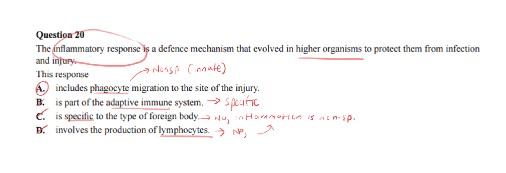As someone who has gone through many years of high school and university, I have become very acquainted with exams. If you want to pass your exams you have to make sure that you study, practice and work hard at nailing the content. However, sometimes you’ll find that no matter how much you study, you lose marks. Sometimes this is due to misreading a question or going too fast.
Annotating exam questions is something my year 12 Biology teacher taught/forced me to do. At the time it seemed like a waste of time but it drastically improved my results in bio and was one of the skills I learnt in school that directly transferred to uni. I still annotate my exam questions now. Even if you ‘know your stuff’, it’s useless if you don’t answer the question properly.
Though it may take a little more time, being able to decipher what the examiner is asking and answer it according to this, will help you gain more marks in exams. We’re trying to figure out what the examiner wants us to write, not everything we know about the topic.
How to do it
I’m using a question from the 2016 VCE biology exam for this example. This technique can be applied to both short and long answer questions. It’s most useful when you have a big chunk of text and you’re trying to draw the question out of it.
Identifying the subject
The first thing you do is try and identify the subject. You’ve covered so many topics that there’s a lot of knowledge in your head. What do we apply? I’ve circled the word ‘inflammatory response’ because this is what the question is about. Now I can start thinking about what I know about the subject.

What is the question?
Next you’ll want to identify the question. This one is straight forward and doesn’t have any ‘question’ in it- you’re asked to complete the sentence. You want to mark words like describe, discuss, who, what, when, where, why and how because they will tell you what the question is asking. You also want to take note of any negative questions e.g. what is NOT the case? This doesn’t happen so much in high school, but will in uni.
Another situation you might have is a question with a large amount of text, where the question is embedded. You want to identify the question and separate it from the information.
Important details
Sometimes questions will have certain circumstances surrounding the question that help you narrow down the answer. These are underlined in the main question above. I’ve underlined ‘higher organisms’. The fact that we’re only talking about the inflammatory response in higher organisms means we’re not thinking about bacteria and plants, which have different defence systems.
Answers
I annotate the answer by highlighting what is special and specific to the answer. I’ve highlighted phagocyte, adaptive immune, specific and lymphocytes. Words like ‘specific’ and ‘always’ can sometimes trick you as the question may be partially true, but ultimately false.

I find the easiest way to answer a question is by crossing out the answers you know are wrong and narrowing it down. Even if you know the answer, it can still be good to negate the others. I usually write down notes next to them as to why they’re wrong, this helps to make double-checking a lot faster. I don’t have to re-think through the question completely, I have the annotations to guide me.
Marking scheme
Another part of reading the question properly is looking at the marking scheme and seeing how many marks it’s worth. This should also tell you how long to spend on this question. A short answer worth 2 marks will generally have 2 answers or ‘points’ you need to make. This really help you to decipher what the examiner will be looking for.
Another example:

I tried to do another example with a business management exam (never done buis-man though). As you can see, there are 3 components to the question and the first paragraph is basically irrelevant. We focus on the second paragraph as the actual ‘question’.
- Describe the relationship between
By breaking the question down, you can make sure you cover the whole question and answer all relevant pieces.
I hope that you enjoyed this educational post! It can seem tedious and dry to annotate your questions but it’s a worthwhile study habit to start introducing. Sometimes it seems like overkill for a simple question but it’s important to practise so you can do it fast in an exam setting. This is one of the most helpful things I learnt in high school as you can apply it to almost any exam (especially in Science).
Did you find this post useful? Or if you’ve been annotating your exam questions, how do you do it? Let me know in the comments section!






